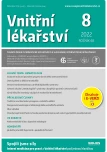Antithrombotic therapy and digestive endoscopy
Authors:
Jiří Cyrany 1; Radovan Malý 2; Stanislav Rejchrt 1; Ilja Tachecí 1
Authors‘ workplace:
II. interní gastroenterologická klinika, Lékařská fakulta Univerzity Karlovy a Fakultní nemocnice Hradec Králové
1; I. interní kardioangiologická klinika, Lékařská fakulta Univerzity Karlovy a Fakultní nemocnice Hradec Králové
2
Published in:
Vnitř Lék 2022; 68(8): 538-542
Category:
In Brief
doi:
https://doi.org/10.36290/vnl.2022.113
Overview
Antithrombotic therapy and digestive endoscopy Antithrombotic therapy comprises anticoagulation and antiplatelet treatment. The number of patients treated with various forms of antithrombotic therapy is growing. Procedures of digestive endoscopy are very frequently indicated by general practitioners and doctors of various specialisations. Interdisciplinary cooperation and mutual understanding are required in order for digestive endoscopy to be effective and safe. Hence, we present an overview based on recent European, British (1), and North American guidelines (2) for endoscopic procedures, with respect to guidelines for perioperative care in general (3).
Antithrombotic therapy management in patients undergoing digestive endoscopy procedures is based on individual consideration of postprocedural bleeding (particularly a delayed one) on one hand, and thromboembolic risk on the other hand, ideally in cooperation with the physician prescribing antithrombotic therapy. Despite all efforts, patients taking antithrombotic medication are at a higher risk of postprocedural bleeding in comparison with those without this risk; this fact should be accepted by attending physicians and patients should be informed of it. Postprocedural bleeding is mostly manageable with a subsequent endoscopic procedure. By contrast, cerebral and cardiovascular thromboembolic complications are often life-threatening and not uncommonly disabling. One should always consider postponing an elective procedure in a patient with temporary antithrombotic therapy (after pulmonary embolism or after coronary stent insertion).
Basic principles of administration of antithrombotic therapy in the context of an endoscopic procedure are described in Table 1. Digestive endoscopy procedures can be categorized according to postprocedural bleeding risk (Table 2). Postprocedural bleeding risk can be specifically reduced in some procedures (ERCP with papillary balloon dilation instead of sphincterotomy, mechanical securing of polypectomy base, etc.).
Acetylsalicylic acid administered as secondary prevention (primary preventive indications are very narrow nowadays) should not be discontinued perioperatively (discontinuation is associated with an approximately threefold increase in thrombotic complications!). The riskiest procedures are the only exception in which discontinuation is explicitly requested by the digestive endoscopist. Reduction of dual antiplatelet therapy is better abandoned in high-risk patients – particularly those with recently implanted coronary stents (Table 3) – and postponement of an elective procedure should always be considered.
Bridging of warfarin with low-molecular-weight heparin (LMWH) is not indicated routinely (in some cases, this practice increases the bleeding risk). Bridging with LMWH is appropriate in patients with high (or moderate) thromboembolic risk (Table 5). Furthermore, LMWH therapy carries specific risks, particularly in patients with renal function impairment (Table 4). In patients with a high thromboembolic risk, a statement of the physician indicating anticoagulation is always appropriate before an elective procedure (Table 6).
Direct oral anticoagulants (DOACs) should not be administered on the day of the procedure, not even in one with a low risk (e.g., biopsy); a longer withdrawal is recommended in high-risk procedures (this cessation should not be bridged with LMWH given the rapid onset and elimination half-time) (Table 7).
Recommencement of antithrombotic therapy after a high-risk endoscopic procedure should always be determined by the endoscopist and the recommended intervals should be considered minimal: 1–2 days after the procedure in the case of P2Y12 inhibitors; 2–3 days after the procedure in the case of DOACs; in the evening of the day of the procedure for warfarin with a maintenance (not saturation) dose; and 48 hours after the procedure in the case of LMWH at a therapeutic dose. Earlier administration of a lower-than-therapeutic dose of LMWH (twice a day per weight) can be considered in this context: prophylactic (once a day) or higher prophylactic (once a day per weight) doses. In general, a full anticoagulation effect should not be achieved earlier than approximately 48 hours after the procedure.
The patient should be properly informed of the course of antithrombotic therapy before and after the endoscopic procedure, including a written form (a calendar can be downloaded online for this purpose)
Keywords:
Antiplatelet therapy – direct oral anticoagulants – anticoagulation therapy – antithrombotic therapy – digestive endoscopy – postprocedural bleeding
Sources
1. Veitch AM et al. Endoscopy in patients on antiplatelet or anticoagulant therapy: BSG and ESGE guideline update. Endoscopy. 2021;53:947-69.
2. Abraham NS et al. ACG‑CAG clinical practice guideline: management of anticoagulants and antiplatelets during acute gastrointestinal bleeding and the periendoscopic period. Am J Gastroenterol. 2022;117:542-558.
3. Douketis JD et al. Perioperative management of antithrombotic therapy: an American College of Chest Physicians clinical practice guideline executive summary. Chest. 2022;162:E207-E243.
4. Státní ústav pro kontrolu léčiv. Clexane, SPC – Souhrn údajů o přípravku. https://www.sukl. cz/modules/medication/download.php?file=SPC182993.pdf & type=spc & as=clexane‑spc.
5. Ortel TL. Perioperative management of patients on chronic antithrombotic therapy. Blood. 2012;120:4699-4705.
6. Halvorsen S, Mehilli J et al. 2022 ESC guidelines on cardiovascular assessment and management of patients undergoing non‑cardiac surgery. Eur Heart J. 2022;43:3826-3924.
Labels
Diabetology Endocrinology Internal medicineArticle was published in
Internal Medicine

2022 Issue 8
Most read in this issue
- Selected severe „haematological“ syndromes in adult intensive care patients
- Today's view of hereditary thrombophilia
- Allergen immunotherapy in treating allergic eosinophilic asthma
- Antithrombotic therapy and digestive endoscopy
